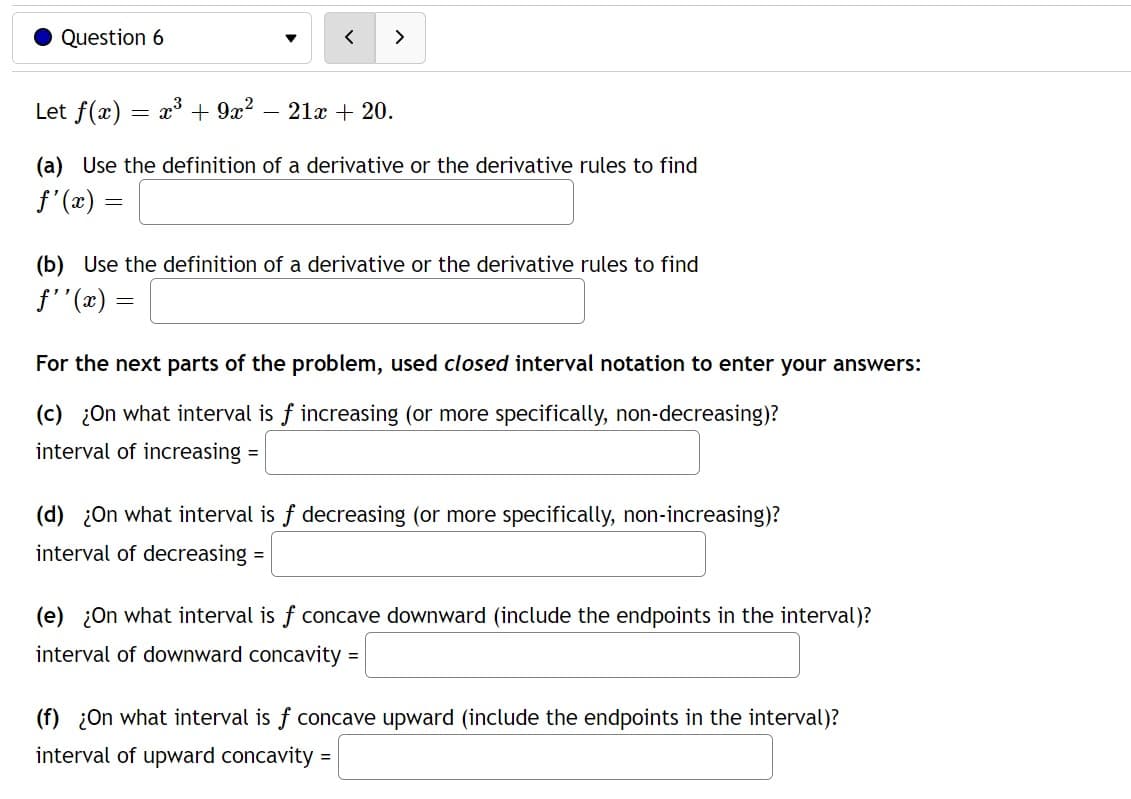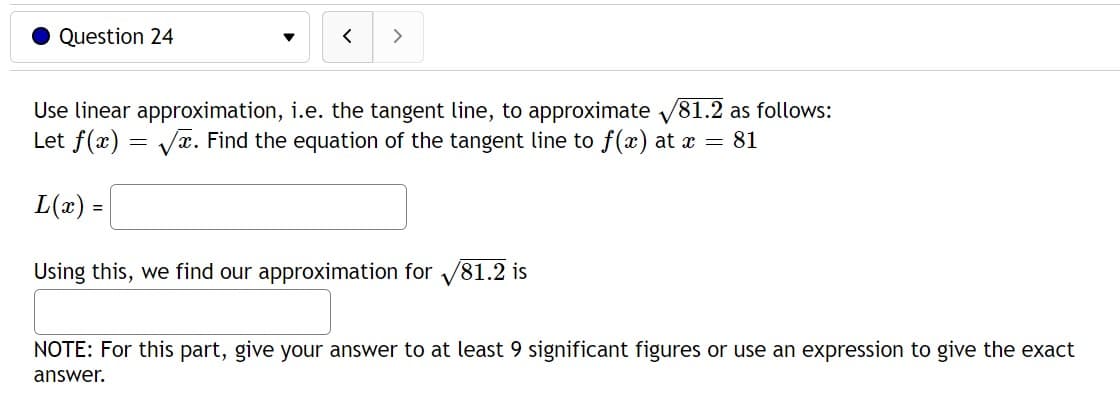Let f(x) x³ + 9x² - 21x + 20. = (a) Use the definition of a derivative or the derivative rules to find ƒ'(x) = (b) Use the definition of a derivative or the derivative rules to find ƒ''(x) = For the next parts of the problem, used closed interval notation to enter your answers: (c) ¿On what interval is f increasing (or more specifically, non-decreasing)? interval of increasing = (d) ¿On what interval is f decreasing (or more specifically, non-increasing)? interval of decreasing = (e) ¿On what interval is f concave downward (include the endpoints in the interval)? interval of downward concavity= (f) ¿On what interval is f concave upward (include the endpoints in the interval)?
Let f(x) x³ + 9x² - 21x + 20. = (a) Use the definition of a derivative or the derivative rules to find ƒ'(x) = (b) Use the definition of a derivative or the derivative rules to find ƒ''(x) = For the next parts of the problem, used closed interval notation to enter your answers: (c) ¿On what interval is f increasing (or more specifically, non-decreasing)? interval of increasing = (d) ¿On what interval is f decreasing (or more specifically, non-increasing)? interval of decreasing = (e) ¿On what interval is f concave downward (include the endpoints in the interval)? interval of downward concavity= (f) ¿On what interval is f concave upward (include the endpoints in the interval)?
Big Ideas Math A Bridge To Success Algebra 1: Student Edition 2015
1st Edition
ISBN:9781680331141
Author:HOUGHTON MIFFLIN HARCOURT
Publisher:HOUGHTON MIFFLIN HARCOURT
Chapter8: Graphing Quadratic Functions
Section: Chapter Questions
Problem 17CT
Related questions
Question
100%
Solve both Questions accurately
For Q6 just solve part c,d,e,f only .
I will give u upvote.Thanks

Transcribed Image Text:Question 6
Let f(x) x³ + 9x²
=
>
21x + 20.
(a) Use the definition of a derivative or the derivative rules to find
ƒ'(x) =
(b) Use the definition of a derivative or the derivative rules to find
ƒ''(x) =
=
For the next parts of the problem, used closed interval notation to enter your answers:
(c) ¿On what interval is f increasing (or more specifically, non-decreasing)?
interval of increasing
(d) ¿On what interval is f decreasing (or more specifically, non-increasing)?
interval of decreasing =
(e) ¿On what interval is f concave downward (include the endpoints in the interval)?
interval of downward concavity =
(f) ¿On what interval is f concave upward (include the endpoints in the interval)?
interval of upward concavity =

Transcribed Image Text:Question 24
< >
Use linear approximation, i.e. the tangent line, to approximate √81.2 as follows:
Let f(x)=√x. Find the equation of the tangent line to f(x) at x = 81
L(x) =
Using this, we find our approximation for V
/81.2 is
NOTE: For this part, give your answer to at least 9 significant figures or use an expression to give the exact
answer.
Expert Solution
This question has been solved!
Explore an expertly crafted, step-by-step solution for a thorough understanding of key concepts.
Step by step
Solved in 2 steps with 2 images

Recommended textbooks for you

Big Ideas Math A Bridge To Success Algebra 1: Stu…
Algebra
ISBN:
9781680331141
Author:
HOUGHTON MIFFLIN HARCOURT
Publisher:
Houghton Mifflin Harcourt

Algebra & Trigonometry with Analytic Geometry
Algebra
ISBN:
9781133382119
Author:
Swokowski
Publisher:
Cengage


Big Ideas Math A Bridge To Success Algebra 1: Stu…
Algebra
ISBN:
9781680331141
Author:
HOUGHTON MIFFLIN HARCOURT
Publisher:
Houghton Mifflin Harcourt

Algebra & Trigonometry with Analytic Geometry
Algebra
ISBN:
9781133382119
Author:
Swokowski
Publisher:
Cengage


College Algebra (MindTap Course List)
Algebra
ISBN:
9781305652231
Author:
R. David Gustafson, Jeff Hughes
Publisher:
Cengage Learning